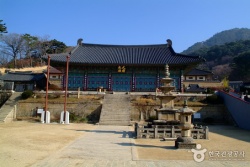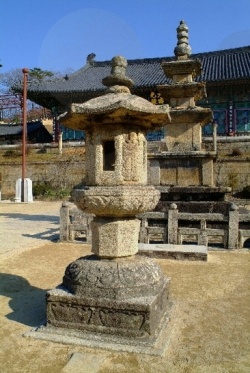Difference between revisions of "Haeinsa Temple (해인사)"
(Created page with "thumb|250px| Haeinsa Temple was founded during the third year of King Ae-Jang's reign (802), by two monks Suneung and Ijung. The name "Haein" originates f...") |
|||
| Line 1: | Line 1: | ||
[[File:2141.jpg|thumb|250px|]] | [[File:2141.jpg|thumb|250px|]] | ||
| − | Haeinsa Temple was founded during the third year of King Ae-Jang's reign (802), by two | + | Haeinsa Temple was founded during the third year of King Ae-Jang's reign (802), by two [[Monks]] Suneung and Ijung. The [[Name]] "Haein" originates from the expression Haeinsammae of Hwaeomgyeong ([[Buddhist]] [[Scripture]]), which means truly [[Enlightened]] [[World]] of [[Buddha]] and our naturally undefiled [[Mind]]. |
| − | Along with | + | Along with [[The Tripitaka]] Koreana (National Treasure No.32) and Janggyeongpanjeon (National Treasure No. 52), 15 more public treasures and some 200 private treasures are enshrined at Haeinsa Temple, which has been appointed as a universal cultural heritage since December, 1995 for its many cultural properties and historical remains. Iljumun, Daejeokgwangjeon and [[The Tripitaka]] Koreana are recognized as famous treasures. Iljumun Gate was the first gate that every [[Sattva]] must pass to become a [[Buddha]] and considered as a representative work of ancient architecture. Daejeokgwangjeon, the grand [[Sanctuary]], and the three-story stone [[Pagoda]] in the yard possess the majestic appearance of the one thousand-year-old temple. Since the 23rd year of Goryeo Dynasty (year 1236), it took 16 years to finish [[The Tripitaka]] Koreana, the most famous national treasure of Haeinsa Temple, which was made as a wish to overcome the national crisis caused by [[Mongolia]] Invasion. The [[Printing]] blocks are 68cm wide, 24.5cm long, 3 cm thick with wood fixed at each end to maintain [[Balance]] and lacquer was applied to prevent corrosion. Silver magnolias growing near the South Sea and Geojae area were cut down, soaked in sea water for several years and then dried to make these [[Printing]] blocks. The blocks are a result of the king and his people's effort to repulse the Mongolian army with support from [[Buddha]]. The 81,340 blocks include 6,791 volumes. |
[[File:214182.jpg|thumb|250px|]] | [[File:214182.jpg|thumb|250px|]] | ||
| − | * More Attractions: Hapcheon 8 gyeong, Haeinsa Temple, Mt. Gaya, Hongryudong Valley (Crimson Stream Village Valley), Mt. Namsanjeilbong, Hambyeongnu Tower, Hwanggye Falls, Mt. Hwangmae Mosanjae, Lake Hapcheon, Baek-ri Cherry Blossom Road | + | * More Attractions: Hapcheon 8 gyeong, Haeinsa Temple, Mt. [[Gaya]], Hongryudong Valley (Crimson Stream Village Valley), Mt. Namsanjeilbong, Hambyeongnu Tower, Hwanggye Falls, Mt. Hwangmae Mosanjae, Lake Hapcheon, Baek-ri Cherry Blossom Road |
{{R}} | {{R}} | ||
[http://english.visitkorea.or.kr/enu/SI/SI_EN_3_1_1_1.jsp?cid=264238 english.visitkorea.or.kr] | [http://english.visitkorea.or.kr/enu/SI/SI_EN_3_1_1_1.jsp?cid=264238 english.visitkorea.or.kr] | ||
Revision as of 13:09, 23 June 2013
Haeinsa Temple was founded during the third year of King Ae-Jang's reign (802), by two Monks Suneung and Ijung. The Name "Haein" originates from the expression Haeinsammae of Hwaeomgyeong (Buddhist Scripture), which means truly Enlightened World of Buddha and our naturally undefiled Mind.
Along with The Tripitaka Koreana (National Treasure No.32) and Janggyeongpanjeon (National Treasure No. 52), 15 more public treasures and some 200 private treasures are enshrined at Haeinsa Temple, which has been appointed as a universal cultural heritage since December, 1995 for its many cultural properties and historical remains. Iljumun, Daejeokgwangjeon and The Tripitaka Koreana are recognized as famous treasures. Iljumun Gate was the first gate that every Sattva must pass to become a Buddha and considered as a representative work of ancient architecture. Daejeokgwangjeon, the grand Sanctuary, and the three-story stone Pagoda in the yard possess the majestic appearance of the one thousand-year-old temple. Since the 23rd year of Goryeo Dynasty (year 1236), it took 16 years to finish The Tripitaka Koreana, the most famous national treasure of Haeinsa Temple, which was made as a wish to overcome the national crisis caused by Mongolia Invasion. The Printing blocks are 68cm wide, 24.5cm long, 3 cm thick with wood fixed at each end to maintain Balance and lacquer was applied to prevent corrosion. Silver magnolias growing near the South Sea and Geojae area were cut down, soaked in sea water for several years and then dried to make these Printing blocks. The blocks are a result of the king and his people's effort to repulse the Mongolian army with support from Buddha. The 81,340 blocks include 6,791 volumes.
- More Attractions: Hapcheon 8 gyeong, Haeinsa Temple, Mt. Gaya, Hongryudong Valley (Crimson Stream Village Valley), Mt. Namsanjeilbong, Hambyeongnu Tower, Hwanggye Falls, Mt. Hwangmae Mosanjae, Lake Hapcheon, Baek-ri Cherry Blossom Road

